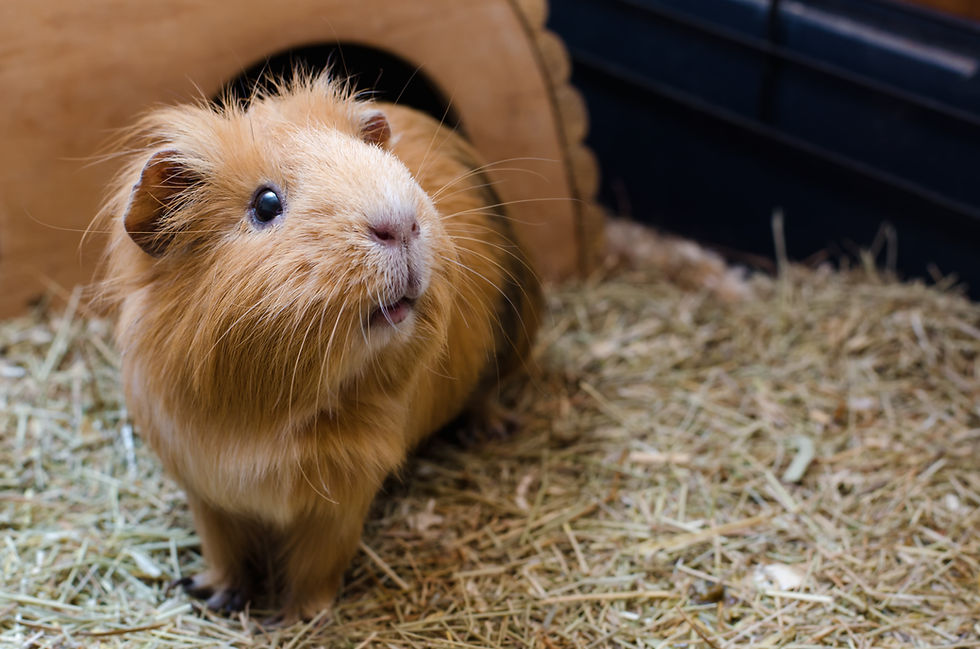Feeding Tips for a Healthy, Happy Rabbit
- Megan McKenzie
- Oct 27
- 3 min read
When it comes to caring for your rabbit, nutrition is everything. Feeding the right diet keeps your bunny healthy, energetic, and full of personality. Rabbits are strict herbivores—they eat only plant-based foods—and their bodies are beautifully designed for a high-fibre, grass-based diet.
In the wild, rabbits spend 6–8 hours a day grazing on grass. Their teeth, stomach, and intestines have all evolved for this natural rhythm of constant nibbling. Mimicking this wild diet is the key to keeping your pet rabbit in top condition.
So, what does a balanced rabbit diet look like? Let’s break it down.
1. The Foundation: Unlimited Grass and Hay (Around 80% of the Diet)
Hay and grass should make up the majority of your rabbit’s daily intake. They provide the essential fibre needed for digestive health and encourage long chewing sessions that naturally wear down teeth and prevent dental disease.
Choose from high-quality grass hays such as Timothy, Oaten, Wheaten, Pasture, Paddock, Meadow, or Ryegrass hay.Avoid feeding too much Lucerne (alfalfa) or Clover hay, as these are too high in protein and calcium.
Tip: Keep hay available at all times — your rabbit should always have something to munch on!
2. Daily Greens: Fresh Vegetables and Leafy Plants
Next up, add plenty of fresh greens. As a guide, offer two packed cups of leafy greens per kilogram of body weight each day.
Some excellent options include:
Broccoli, celery, endive, beet tops, carrot tops, Brussels sprouts
Spinach leaves, bok choy, and other Asian greens
Dark-leaf lettuce varieties (avoid iceberg lettuce)
Fresh herbs like parsley, coriander, basil, dill, mint, and dandelion
Rotate greens regularly for variety and balanced nutrition.
3. Healthy Treats (in Moderation)
Treats can be a great way to bond with your bunny — just remember that less is more.Limit treats to 1–2 tablespoons per rabbit per day, and choose natural, healthy options such as:
Small pieces of fruit
Root vegetables like carrot or sweet potato
Capsicum (bell pepper)
Avoid sugary or processed snacks made for other pets — your rabbit’s gut flora is delicate and depends on fibre, not sugar.
4. Supplement Smartly with Green Valley Grains Pellets or Mix
While hay and greens form the foundation of a healthy rabbit diet, a small amount of a high-quality pellet or mix can be a fantastic supplement — ensuring your rabbit gets the vitamins and minerals needed for optimal health.
That’s where Green Valley Grains Rabbit & Guinea Pellets and Green Valley Grains Rabbit & Guinea Mix come in.
Green Valley Grains Rabbit & Guinea Pellets
Formulated with high-fibre ingredients and enriched with:
Natural Vitamin E and Vitamin C
Yucca extract and yeast culture for digestive health
A complete vitamin and mineral premix
These pellets provide a consistent source of essential nutrients to complement your rabbit’s natural diet.
Green Valley Grains Rabbit & Guinea Mix
Prefer a textured option? The muesli-style mix includes:
Lucerne and oaten chaff, steamed flaked oats, maize, lupins, and sunflower seeds
Omega-enriched canola oil for coat health
A full vitamin and mineral premix
This mix is highly palatable, making it a great choice for fussy eaters.
Why Add a Pellet or Mix?
Ensures a complete nutritional balance, especially when fresh greens are limited.
Provides extra energy and nutrients for growing or active rabbits.
Supports healthy digestion and coat condition.
Makes feeding simple, measured, and consistent.
Feed pellets or mix in small quantities — just enough to supplement the hay and greens, not replace them. Always introduce any new food gradually over 2–3 weeks to prevent tummy upsets.
5. Encourage Chewing and Play
Rabbits love to chew! It’s not just for fun — it’s essential for keeping their teeth healthy.Provide safe, chewable items like:
Wooden chew blocks
Untreated willow branches
Old (non-glossy) telephone books or cardboard boxes
This helps satisfy their natural instincts and prevents boredom.
6. Keep Feeding Consistent
Rabbits have sensitive digestive systems, so consistency is key. Avoid sudden diet changes — always transition gradually over 2–3 weeks when introducing new foods, including pellets or mixes.
7. Fresh Water — Always!
Finally, never forget the simplest part of the diet: fresh, clean water.Provide unlimited access at all times, whether in a bowl or a sipper bottle, and change it daily.
The Takeaway
A healthy rabbit diet is all about balance, fibre, and consistency:
Hay and grass form the base.
Leafy greens and herbs bring variety.
Small amounts of high-quality pellets or mix, like those from Green Valley Grains, round out the diet with essential nutrients.
By combining natural foraging with nutritionally complete feeds, you’ll be setting your rabbit up for a long, healthy, and happy life.




.png)


Comments